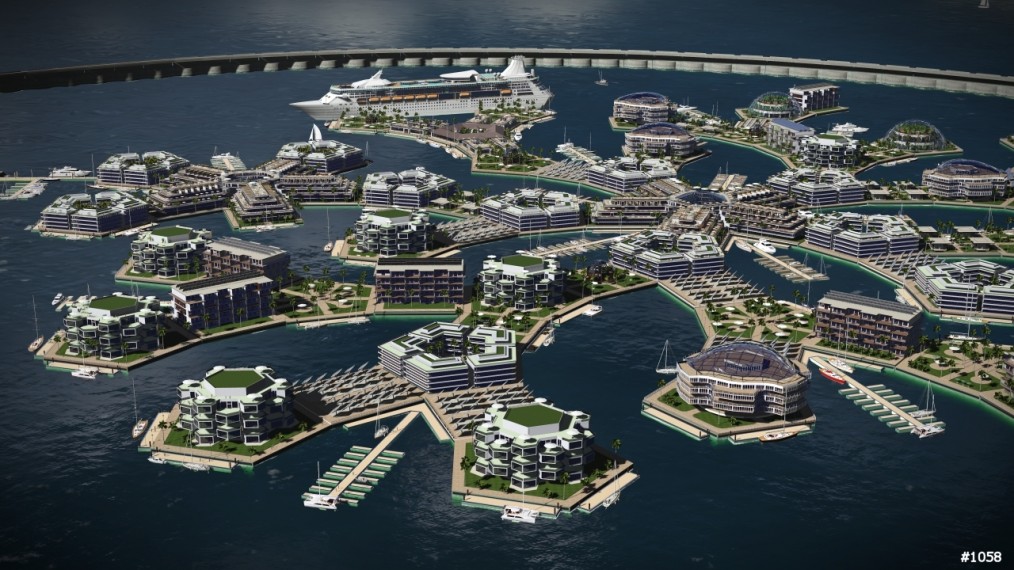Why Architects Must Be Leaders of Adaptation

Floating cities will be just one of many imaginative adaptations to the increasing challenge of short term flooding and long term rising sea level. Architects will be at the forefront of designing a range of viable solutions for the new era just coming into view. ( Image from www.seasteading.org/architectural-design-contest/artisanopolis/ )
When the subject of flooding arises, either the short-term varieties of rainfall, storms, and extreme tides, or the long-term problem of rising sea level, we tend to look at the negative aspects and the potential loss of coastal communities worldwide. From this perspective, rising water is a huge problem, very much a “glass half empty.” At the risk of sounding sanguine, we need to look at “the glass half filled” aspect too: the new opportunities that will arise out of the need to design communities of the future, ones that can sustain the increased intermittent flooding as well as the new era when sea level will be much higher than present, essentially permanently. Architects need to be key agents of that change.
From my perspective, how we adapt is the critical and really interesting question. Humans are the masters of adaptation. While we must reduce the warming and climate change as a matter of the absolute highest priority, we are now in a situation where we have to begin planning and effecting ADAPTATION in parallel with any efforts to slow the warming. Of all the adaptation issues, rising sea level and the unstoppable shifting shoreline is one of the most challenging.
For good reason over the last several decades architects and engineers have focused on ways to reduce the rate of warming by making buildings more energy efficient. They have made terrific progress, perhaps best recognized with the LEED technologies and rating system developed through the US Green Building Council. That has been an important part of making us more energy efficient and slowing the greenhouse gas emissions associated with warming. But we have passed a tipping point with CO2 levels now above four hundred PPM (Parts per million) and the oceans being about one and a half degrees Fahrenheit warmer than in the last few thousand years. The planet is in a new state unable to quickly return to the equilibrium of the last eleven thousand years, known as the holocene. The melting of glaciers, the rise of sea level and extreme rainfall can be slowed but must now be accepted as a new reality.
Many professions and sectors must be engaged in this new effort including the financial sector, planners, real estate developers, engineers, strategic planners, national security, and those responsible for building codes. Architects have a unique skill set and opportunity to be leaders for an obvious reason. Architects are the primary group that is trained and looked to for a combination of three perspectives for our built environment.
First and foremost, buildings must be structurally sound, providing a safe and healthy space, given the environmental risks of that location.
Second, buildings must be functional for a particular purpose with flexibility for adaptation.
Third, they should be aesthetically appealing so that they are embraced by the owners, users, and wider community
In other words architects look at building opportunities both from a technical and practical aspect, as well as a creative and artistic perspective. In the United States, the American Institute of Architects – “AIA” – is the dominant professional association, with partner chapters in most states and internationally. As evidence of their rapidly rising awareness of these issues, last Friday (October 13) their magazine, ARCHITECTS had a feature, THE PARADOX OF WATER. At the top of the list of topics was the challenge of flooding and rising sea level. I am honored and delighted that my work was featured, PLANNING FOR THE INEVITABLE.

An example of innovative design can be seen in HafenCity, part of Hamburg Germany, enabling them to cope with the extreme flooding they experience often from the Elbe River – up to 20 feet (6 meters).
Led by the Florida chapter I am excited to see that Architects are now looking seriously at the challenge posed by sea level and the other flooding factors. We are now in the process of creating specific programs to give architects and their related colleagues the knowledge and tools for this new era. If you are an architect, engineer, planner or related professional and would like to be notified about new information and educational offerings becoming available, please send your contact information to: architects@johnenglander.net.
Though there will be tremendous economic opportunities, I don’t want to trivialize the reality. Globally trillions of dollars of assets are at risk and much will go underwater. But this is a situation where the value of what will be lost can be offset by the value of new communities designed to be sustainable. Those that can see and plan for the future can be prepared and can even profit.
Rising with the tide is not optional. Let’s seize it as an opportunity.
